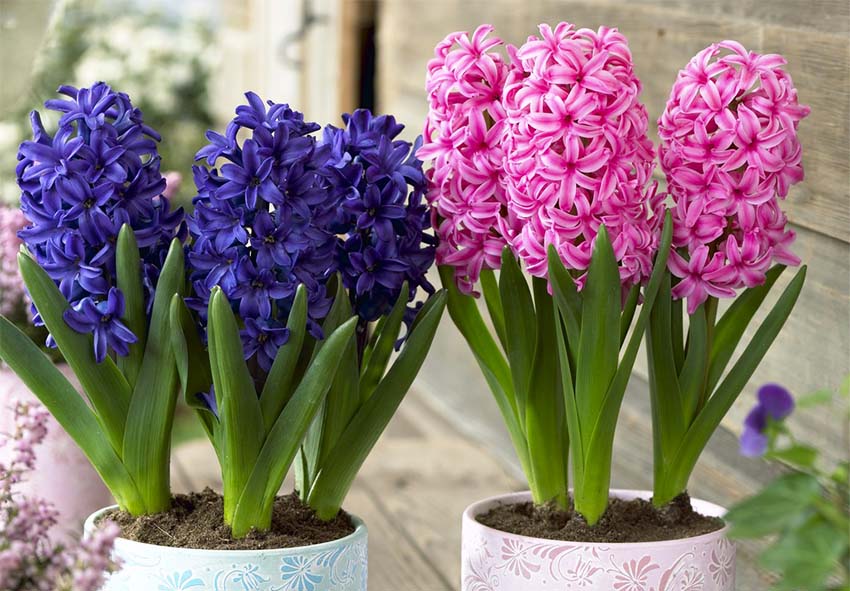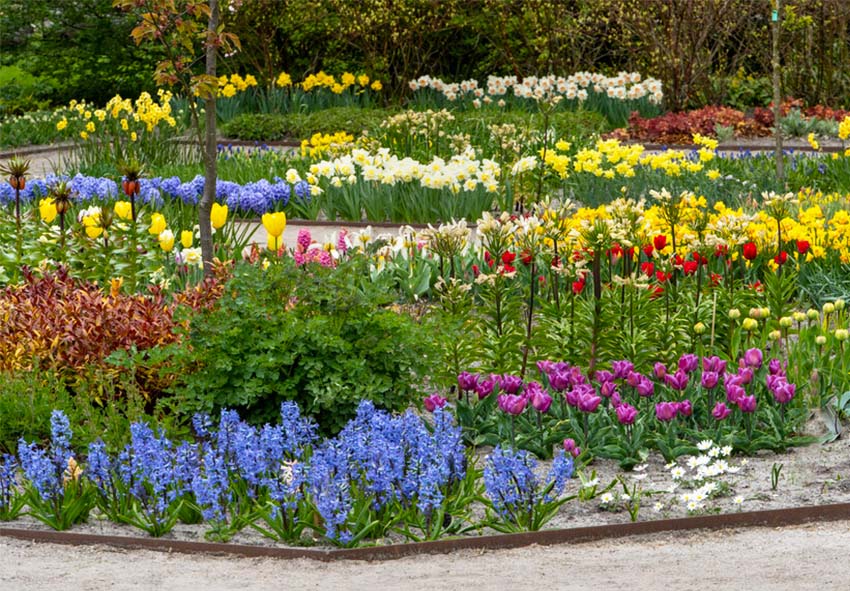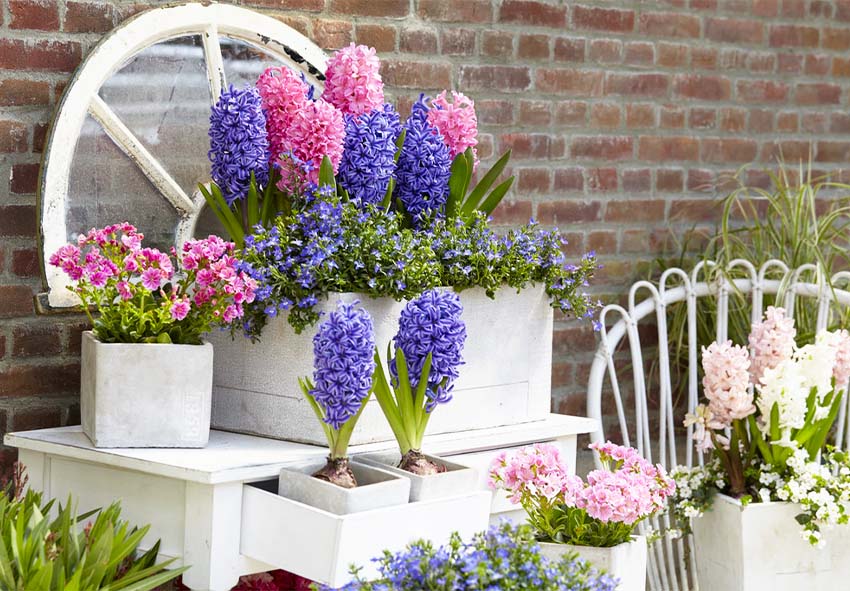Hyacinths are a popular choice for garden design due to their versatile nature and delightful fragrance. These spring bulbs produce clusters of vibrant, colorful flowers that add beauty to any landscape. Ideal for various garden styles, hyacinths can be used to create stunning displays with ease. This article will explore color schemes, planting combinations, and tips for designing with hyacinths to help gardeners create beautiful, fragrant spaces. Our gardening blog is a perfect place to find all the information you need!
Why Choose Hyacinths for Garden Design?

Hyacinths are a favorite among gardeners for their vibrant colors and captivating fragrance. They bring charm to any garden style, whether traditional or modern, making them an ideal choice for versatile garden design. Their ability to thrive in various settings adds to their appeal as a must-have spring bulb.
Aesthetic Appeal of Hyacinths
Hyacinths are known for their lush, clustered flowers that come in a wide range of colors, including shades of blue, pink, purple, white, and yellow. The dense flower spikes create a vibrant display, and their pleasing fragrance adds another layer of sensory enjoyment to the garden. Whether used as a focal point or combined with other flowers, hyacinths bring life and color to any space, enhancing the overall garden atmosphere.
Easy Integration into Various Garden Styles
The versatility of hyacinths makes them suitable for different garden styles, from traditional cottage gardens to more modern, formal designs. Their adaptability allows them to be planted in borders, beds, or containers, making it easy to incorporate them into existing garden layouts. Here are some ideas for you:
- Cottage Gardens: Hyacinths add charm to cottage gardens with their classic, old-fashioned appeal. They pair well with other spring flowers like daffodils and tulips for a traditional look.
- Formal Gardens: Use hyacinths to create structured beds or symmetrical patterns for a polished appearance.Their dense, clustered blooms fit perfectly in formal garden layouts.
- Modern Gardens: Incorporate hyacinths for pops of color among minimalist plantings. Use monochromatic hyacinth varieties to add a sleek, contemporary touch.
- Container Gardens: Hyacinths thrive in pots, window boxes, and planters, making them ideal for small spaces. Combine with other compact bulbs or trailing plants for added visual interest.
- Rock Gardens: Plant hyacinths in rock gardens to add color among stones and hardy perennials. Choose dwarf varieties to fit the scale of the setting.
- Mixed Borders: Place hyacinths in mixed borders to create layers of color and texture. Combine with evergreen shrubs for year-round structure and contrast.
Best Color Schemes for Hyacinths
Hyacinths come in a stunning array of colors, offering endless possibilities for beautiful garden displays. Whether you prefer bold monochromatic themes, complementary color pairings, or gentle pastel palettes, hyacinths can create eye-catching combinations. Thoughtful color selection helps enhance the overall atmosphere of your garden.
Monochromatic Color Themes
A monochromatic color scheme using hyacinths involves planting flowers of a single color, creating a bold and unified look. For instance, an all-blue hyacinth bed can provide a serene, calming effect. For added depth, gardeners can incorporate various shades of the same color, such as pale pink and deep magenta hyacinths, to create visual interest while maintaining a harmonious appearance.
Complementary Color Schemes
Using complementary colors, such as pairing purple hyacinths with yellow flowers, can create a striking contrast that stands out in the garden. When selecting complementary colors, using the color wheel as a guide can help achieve an effective balance. For example, purple hyacinths can be paired with bright yellow daffodils for a classic spring look, while pink hyacinths can be matched with light blue forget-me-nots for a softer contrast.
Pastel-Themed Gardens
For a soothing and calming garden atmosphere, pastel-themed designs with soft-colored hyacinths are ideal. Shades of light pink, lavender, and pale blue hyacinths can be paired with other pastel-toned spring flowers like hellebores and primroses. This approach creates a gentle, romantic look, perfect for gardens aiming for a serene and welcoming vibe.
Ideal Planting Combinations with Hyacinths

Pairing hyacinths with other plants can enrich the garden’s beauty and extend the blooming season. They work well with early spring bulbs, perennials, and even in containers. Combining them with different plants helps create layered, visually appealing displays. More information about planting and care can be found in our full guide for Hyacinths.
Pairing Hyacinths with Early Spring Bulbs
Hyacinths can be planted alongside other early-blooming bulbs to create a colorful spring display. Coordinating the bloom periods of these bulbs allows for continuous waves of color throughout the season. For example:
- Tulips: Plant hyacinths alongside tulips for a colorful spring display. Choose complementary or contrasting colors to create striking visual effects.
- Daffodils: Pair hyacinths with daffodils to extend the blooming season. Use the tall, bright yellow daffodils as a backdrop to the shorter, vibrant hyacinths.
- Crocuses: Combine hyacinths with early-blooming crocuses for a burst of early spring color. Plant crocuses in clusters around hyacinths to create a naturalistic look.
- Snowdrops: Use snowdrops to complement hyacinths with delicate, white flowers. The early-blooming snowdrops provide a soft contrast to the bold colors of hyacinths.
- Scillas (Squill): Pair hyacinths with blue scillas for a cool-toned, harmonious garden palette. The smaller scilla flowers can fill in spaces around the larger hyacinth blooms.
- Iris Reticulata: Plant Iris reticulata bulbs near hyacinths to add intricate, deep-hued blooms to the mix. Their early bloom time complements the hyacinths for a diverse color scheme.
Using Hyacinths in Mixed Borders
Hyacinths can also be used in mixed borders with perennials like peonies, irises, and alliums. This combination adds layers of visual interest, with the hyacinths’ bold flower spikes contrasting against the more delicate blooms of perennials. By placing hyacinths near the front of the border, they can be enjoyed up close, while taller plants in the background provide a layered effect that draws the eye through the garden.
Container Planting Ideas
Hyacinths are excellent choices for containers, bringing color and fragrance to patios, balconies, and entryways. In pots or window boxes, they can be paired with smaller bulbs like grape hyacinths or trailing plants such as ivy to create a lush look. Arranging hyacinths in containers at different heights adds dimension and makes the display more dynamic.
Designing with Hyacinths for Year-Round Interest

Hyacinths play an important role in gardens that offer visual appeal throughout the year. By combining them with foliage plants and practicing succession planting, you can create a garden that evolves beautifully across the seasons:
Winter: Add Structure with Evergreen Shrubs
- Incorporate evergreen shrubs like boxwood or holly to provide structure and greenery during winter.
- The evergreens create a sturdy backdrop that keeps the garden visually interesting, even when hyacinths are dormant.
Early Spring: Pair with Early-Blooming Bulbs
- Plant hyacinths alongside other early spring bulbs like crocuses and daffodils for a burst of color.
- This combination brings the garden to life early in the season with overlapping bloom periods.
Mid-Spring: Use Foliage Plants for Texture
- Add foliage plants such as hostas or heucheras to complement hyacinths’ lush flowers.
- As the hyacinths start to fade, the foliage fills in gaps, maintaining the garden’s beauty.
Late Spring: Layer in Late-Spring Perennials
- Combine hyacinths with late-spring perennials like peonies or alliums to extend the flowering period.
- The succession planting approach ensures continuous color and depth as the seasons progress.
Summer: Mix with Ornamental Grasses
- Include ornamental grasses like fountain grass or blue fescue for summer texture and movement.
- Their airy foliage adds a dynamic element to the garden, complementing the structure left by spring flowers.
Autumn: Plant Ground Covers for Fall and Winter Interest
- Add ground covers like ajuga or creeping thyme to maintain garden vibrancy during the cooler months.
- These low-growing plants keep the garden lively and fill in spaces as other plants prepare for winter dormancy.
Combining Hyacinths with Foliage Plants
To maintain garden interest even after hyacinths have finished blooming, combine them with evergreen shrubs or foliage plants. The foliage provides structure and visual interest once the hyacinths have faded. Plants like hostas or heucheras can fill gaps and add texture, ensuring the garden remains attractive even when the hyacinths are no longer in bloom.
Creating Succession Planting
Succession planting involves arranging a variety of plants that bloom at different times to create an evolving display throughout the growing season. Pairing early-blooming hyacinths with mid-season tulips and late-blooming alliums ensures a garden that continuously transforms. This approach allows gardeners to enjoy a sequence of vibrant blooms, keeping the landscape lively and engaging.
Conclusion
Hyacinths are a versatile and fragrant addition to garden design, suitable for various styles and color schemes. With thoughtful planning, they can be paired with complementary plants to create stunning displays that evolve throughout the season. Gardeners are encouraged to experiment with different combinations and designs to find the perfect fit for their space. Explore the range of hyacinth varieties and companion plants available at the online store to start planning your garden’s transformation.
Frequently Asked Questions (FAQs) about Hyacinths in Garden Design
1. How can I use hyacinths to create a color scheme in my garden?
Hyacinths are perfect for creating diverse color schemes due to their vibrant hues. For a bold look, try a monochromatic theme with different shades of a single color, or mix complementary colors, such as purple hyacinths with yellow flowers. Pastel-themed gardens can also benefit from soft-toned hyacinth varieties.
2. What are some good companion plants for hyacinths?
Early spring bulbs like tulips, daffodils, and crocuses pair well with hyacinths, providing continuous color. In mixed borders, combine them with perennials such as peonies, irises, or alliums for added texture. Evergreen shrubs and foliage plants also complement hyacinths by filling in gaps after their bloom period.
3. How can I integrate hyacinths into different garden styles?
Hyacinths are versatile and fit well into various garden styles. In cottage gardens, plant them among other traditional bulbs and perennials. For a formal look, use hyacinths in geometric patterns or borders. In modern gardens, they add a pop of color and contrast when placed against sleek, minimalist backgrounds.
4. Can I order hyacinth bulbs from your online store?
We’re pleased to offer hyacinth for purchase through our online store Dutch-bulbs.com. Ordering from us is convenient, and we ensure that you receive high-quality, healthy tubers. Simply browse our store, choose your favorite hyacinth varieties, and follow the easy ordering process to have them delivered to your doorstep, ready for planting.
5. Can hyacinths be grown in containers, and if so, how?
Yes, hyacinths thrive in containers. Use well-draining soil and plant the bulbs with the pointed end up, ensuring they’re covered by about three inches of soil. Pair them with smaller bulbs, like grape hyacinths, or trailing plants for a fuller display. Place the containers in a sunny spot for optimal growth.
Published: 17.10.2024
